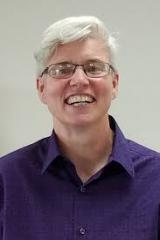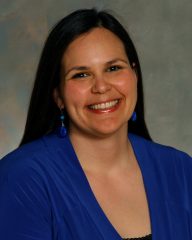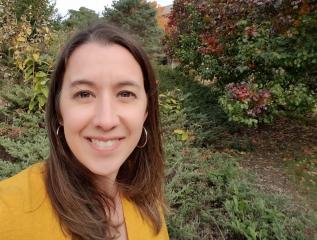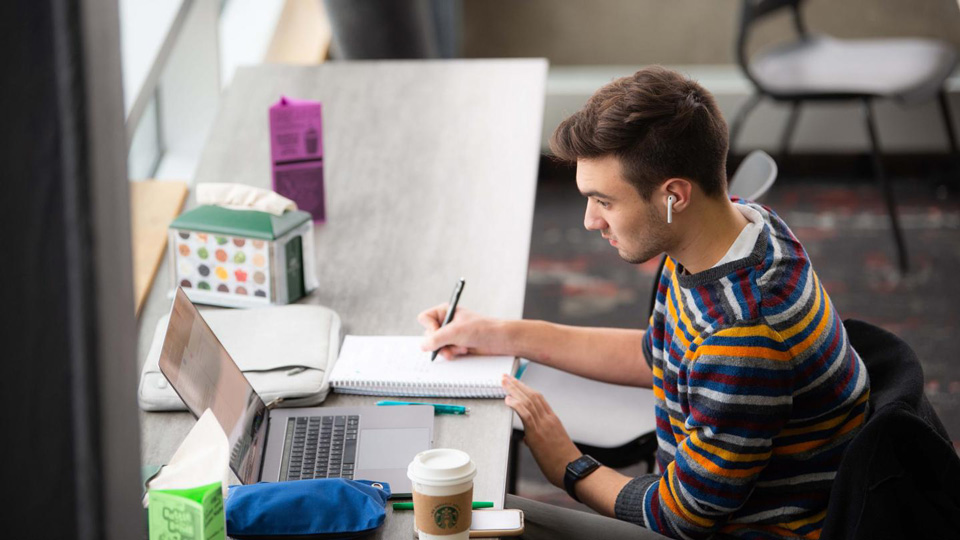When people ask University of Wisconsin Oshkosh instructors what they did with their summer vacation, many will point to the hours and hours of learning they did to get ready for fall 2020.
“There’s a mass movement going on among instructors to create transformational online experiences for the fall for students,” said Jordan Landry, associate professor in the English Department who directs UWO’s Center for Excellence in Teaching and Learning (CETL) and led a summer teaching and learning initiative.

Jordan Landry
CETL offered 21 training sessions over summer on a wide range of ways to plan, create and facilitate a course. And 150 instructors finished a summer online teaching and learning program in mid-August. Landry has “no doubt” that online teaching has been vastly improved through the summer commitment of a large number of instructors—and not just those in the program.
Rewriting the playbook
A seasoned online educator at UWO said the events of March 2020 delivered a “worst case scenario” for instructors–forcing them to abruptly move from face-to-face teaching to online instruction when the UW Oshkosh campuses were closed due to a coronavirus pandemic.
Instructional designer Sarah Bradway said when a student willingly signs up for an online class, they know what to expect and they have the necessary technology and support network in place.
“We didn’t have that—the population of online students suddenly looked very different—they had different needs,” Bradway said. “The students we were now working with had signed up for face-to-face learning because they wanted the experiences that came with that type of learning. We had to throw out the ‘old playbook’ of what worked and what was successful with traditional online populations and rewrite the book for this new environment of social distancing and alternative delivery methods.”
Many instructors mentioned that they shared more of themselves with their students this spring than typical. Landry said the small acts of “being authentic” with students led to greater community in the classroom.
“I heard story after story of instructors going all-out for students—from planning new manageable projects in the interest of boosting student engagement—to creating innovative videos to show students how to complete a lab,” Landry said. “Such efforts take a tremendous amount of time, and instructors were willing to make personal sacrifices to ensure students had the best possible learning experience during the pandemic.”
Listening and adapting
When classes moved to online in the spring, one of the greatest challenges was there was no real model for instructors (who were new to online teaching), on how to move their courses quickly online.
Landry said while many online experts were encouraging instructors to teach asynchronously, their students were begging them to hold synchronous online sessions.
“What impressed me most about instructors going online is how well they listened to their students and adapted their teaching to students’ expressed needs,” Landry said.

Jennifer Considine
UWO Communication Studies Department Chair Jennifer Considine said her department has been gearing up for fall when more than 40 sections of public speaking are held on the three UWO campuses.
Considine said they are reworking classes to make sure students still feel a sense of community as they learn.
Instructors are developing units on public speaking in a virtual environment as well as face-to-face settings. They are using tools like Flipgrid to allow students to make short video posts to practice their impromptu speaking skills and get to know each other a bit more.
Considine said they are making sure they practice the principles of inclusive excellence in classrooms to provide a supportive environment for all students—especially those who have been historically underrepresented on campuses.
Real-world training
Upper level communications classes will be capitalizing on new opportunities for connecting across distances.
- In a normal year, alumni speakers would be invited to classes to share advice with students. This fall, web-conferencing software will give students the ability to connect with alumni all over the country.
- Considine said in her Communication in Nonprofit Organizations course, students will be doing a virtual consulting project with a nonprofit community clinic that provides free healthcare to people in need.
- With the new hybrid model of course delivery, she sees students having the opportunity to develop their abilities in web conferencing, telework and virtual presentations—essential skills in their future careers.
A summer like no other
Instructional designer Bradway said when she reflects on summer 2020, the one thing that continually amazes her is the amount of effort that every person on campus put forth to prepare for the fall semester.
“Groups from around campus came together to plan safety measures, information technology re-imagined classroom setups; faculty, instructors and other staff worked together to plan and implement workshops,” she explained. “Instructors spent hours learning how to teach in this new environment—they made plans and redesigned classes.

Sarah Bradway
“This summer was like no other I’ve ever experienced,” she said, noting that it was an enormous amount of work.
As the fall 2002 semester begins, it will bring new territory for many instructors. No matter how much they prepare, there will be a level of apprehension. The semester will not look like what they’ve been used to.
“We also know technology will most likely fail at some point, people will make mistakes, we will need to adjust and be flexible,” Bradway said. “I keep telling everyone that a healthy dose of grace and forgiveness will go a long way and that includes grace and forgiveness of yourself.”
Learn more:

